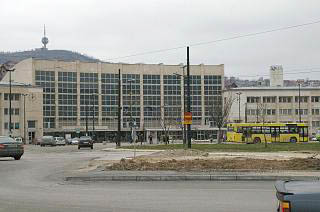
Sarajevo train station
サラエボ駅
Sarajevo in a valley along Milyacka River is a cosmopolitan city where people different directions came, and Catholic and Serb Orhodox Churches and Islamic mosques stand in the same area. Even during the last period of the former Yugoslavia, there were not only those who said that they were Muslim, Serb, Croat, etc. but also Yugoslavian. This has been especially common in Sarajevo. The people there think that they are Sarailija (people of Sarajevo). This makes Sarajevo a unique and attractrive place, although the war made it well known during the 1990s.
But be careful of pickpockets. My backpack was open by a woman and a man, although they could not find any valuables there. That kind of crimes are nwo rampant there.
ミルャッカ川に沿って開けた盆地にあるサラエボは、色々な方向から来た人々が作ったコスモポリタンな町。カトリック教会も、セルビア正教会も、イスラム教のモスクも、同じ地域に一緒に立っています。ユーゴスラビアが分裂してしまう最後の時期にさえも、自分は「モスレム人」であるとか、「セルビア人」であるとか、「クロアチア人」であるとか考える人だけでなく、自分は「ユーゴスラビア人」あると考える人たちも5%以上いました。(下の表を御参照)。そのような感覚は、特にサラエボでは強く、自分たちは「サラエボ人」であると考える人が多かったのです。1990年代の内戦がサラエボを有名にしてしまいましたが、そのようなコスモポリタンな雰囲気こそがサラエボの魅力です。
但し、内戦で少なからぬ市民が難民となった後に、犯罪集団も流れ込んでいます。私も、歩いている時、男女2人組のスリにバックパックを開けられました。貴重品は入れていなかったので実害はありませんでしたが。
サラエボについてとても参考になるウェブサイト:
http://sekitori.web.infoseek.co.jp/war/war_BiH_sarajevo1.html
http://www.famainternational.com/
The following book clarifies the critical fault of the view of "the
crash of civilizations". Not only the human populations have diverse
identities among different persons, but also each person himself/herself
has diverse identities within himself/herself. Each person is not characterized
by only identity of his/her religious belief or nationality but also by
various identities such as profession, hobby, research subject, place of
residence, and many others. Dividing people with one identity is a critical
fault.
紛争について関心のある人に読んで欲しい本(「文明の衝突」という命題自体の根本的誤りがわかります。つまり、人間の集団に多様性があるとともに、個人自体の特性自体にも多様性があります。同じ人が、特定の宗教または特定の国籍という特性だけで特徴づけられる訳ではなく、職業による特性、趣味による特性、専門による特性、同じところに行ったり住んだりしたことがあるという特性等々、個人自体の特性にもたくさんあるのです。そのようにたくさんある特性の一つだけで人々を区分してしまうのは、重大な誤りです。):
Amartya Sen, 2006: Identity and Violence: The Illusion of Destiny, 215 pp. Norton (Also available as a Penguin Book.同じ本がPenguin Booksとしても出ています。どちらの版も、アマゾンで送料が不要にならないほど安くなっています。)
He pointed it out also in the World "Civilization" Forum held
at the United Nations University in Tokyo on 22 July 2005.
彼が同じことを指摘した2005年7月22日東京(国連大学)開催のWorld Civilization
Forumでの彼の話。英語の音声に加え、日本語の同時通訳の声も聞けます。):
http://c3.unu.edu/unuvideo/index.cfm?fuseaction=event.home&EventID=66
Which identities the people of the former Yugoslavia had (1981)
旧ユーゴスラビアの人たちが、自分はどの「民族」に属していると考えたか(1981年)
| 「民族」 Identity | 人口 Population | % | 言語 Language | 宗教 Religion | 文字 Character |
| セルビア人 Serb | 8,140,452 | 36.3 | セルビア語 Serb | ギリシア正教 Orthodox | キリル文字 Cyrillic |
| クロアチア人 Croatian | 4,428,005 | 19.8 | クロアチア語 Croatian | カトリック Catholic | ラテン文字 Latin |
| ムスリム人 Muslim | 1,999,957 | 8.9 | イスラム教 Islam | ||
| スロヴェニア人 Slovenian | 1,753,354 | 7.8 | スロヴェニア語 Slovenian | カトリック Catholic | ラテン文字 Latin |
| アルバニア人 Alabanian | 1,730,364 | 7.7 | アルバニア語 Albanian | イスラム教 Islam | |
| マケドニア人 Macedonian | 1,339,729 | 6.0 | マケドニア語 Macedonian | ギリシア正教 Orthodox | キリル文字 Cyrillic |
| ユーゴスラビア人 Yugoslaivan | 1,219,045 | 5.4 | |||
| モンテネグロ人 Montenegro | 579,023 | 2.6 | セルビア語 Serb | ギリシア正教 Orthodox | キリル文字 Cyrillic |
| ハンガリー人 Hungarian | 426,866 | 1.9 | ハンガリー語 Hangarian | カトリック Catholic | |
| ロマ人 Roma | 168,099 | 0.8 | ロマニー語 Romani | ||
| 合計 | 22,424,711 |
Moslem became Islamic during the period when the area was governed by the
Osman Turk. Hungarians live in the area ceded by Hungary which lost in
the war in 1920. The Serb and Croatian languaes are almost the same and
are called Serb-Croatian but used different characters.
「モスレム人」とは、オスマントルコに支配された時代にイスラム化した人たち。ハンガリー人は、主に、1920年に敗戦国ハンガリーから割譲された地域に住む。セルビア語とクロアチア語はごく近い関係にあるが(「セルビア・クロアチア語」とされる。)、使用文字が異なる。
高崎通浩、2002 「民族対立の世界地図: 欧州/北南米/アフリカ編」 311 pp. 中公新書ラクレ、pp.
163-165
TAKAHASHI Michihiro, 2002: Minzoku Tairitsu no Sekai Chizu (World Map of
Ethnic Conflicts): Europe, Americas and Africa , 311 pp. Chuko Shinsho,
pp. 163-165
Which identities the people of Bosnia and Herzegovina have (1991)
ボスニア・ヘルツェゴヴィナの人たちが、自分はどの「民族」に属していると考えたか(1991年)
| 「民族」 Identity | 人口 Population | % |
| ムスリム人 Moslem | 1,902,956 | 43.48 |
| セルビア人 Serb | 1,366,104 | 31.21 |
| クロアチア人 Croatian | 760,852 | 17.38 |
| ユーゴスラビア人 Yugoslavian | 142,682 | 5.54 |
| ボスニア人 Bosnian | 10,763 | |
| ヘルツェゴヴィナ人 Herzegovinan | 467 | |
| ボシュニャク人 Bosnjaci | 1,285 | |
| 合計 | 4,377,033 |
齋藤厚、2001: 「ボスニア語」の形成、スラヴ研究 48号、pp. 113-137 (北海道大学スラヴ研究センター)
SAITO Atsushi, 2001: Formulation of Bosanski Jenik (Bosnian Language),
Slavic Studies No. 48, pp. 113--137 (Slavic Research Center, Hokkaido University)
同氏は、「新国家ボスニア・ヘルツェゴヴィナにおいて、1990年代半ばに登場した新言語「ボスニア語」は、紛争下、宗教名や他民族名を冠さない民族名、言語名を模索したムスリム人が、「ボシュニャク人」との民族名とともに採用したものであった。そして、この言語は、「従来のセルビア・クロアチア語に若干の確定や変更が加えられる形で事後的に形成されたが、使用にはおよそ移されていない」こと等を明らかにしている。詳しくは:
http://src-h.slav.hokudai.ac.jp/publictn/48/a-saito.pdf
Heclarifies that the Bosanski Jenik, which was formed in the mid-1990s
with modifications to the Serb-Croatian in association with the new ethnic
name of Bosnjaci in search of names of the group and language without showing
the religion and ethnicity in the conflicts, has not been in use in his
paper at: http://src-h.slav.hokudai.ac.jp/publictn/48/a-saito.pdf

| Arrival at Sarajevo | Sarajevo top | Old quarter | Life and new quarter |
| Remnants of war | Viena-Budapest-Sarajevo -Zagreb-Baden top |
The Planet where we live |
Ingredients of Life |